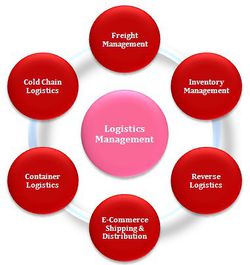Logistics Management
What is Logistics Management?[1]
Logistics Management is the process of strategically managing the procurement, movement, and storage of materials, parts, and finished inventory (and the related information flows) through the organization and its marketing channels in such as way that current and future profitability are maximized through the cost-effective fulfillment of orders.
Logistics Management is a supply chain management component that is used to meet customer demands through the planning, control, and implementation of the effective movement and storage of related information, goods, and services from origin to destination. Logistics management helps companies reduce expenses and enhance customer service. The logistics management process begins with raw material accumulation to the final stage of delivering goods to the destination. By adhering to customer needs and industry standards, logistics management facilitates process strategy, planning, and implementation.[2]
Importance of Logistics Management[3]
Good logistics management ensures that products are shipped in the most economical, safe, efficient, and timely manner. This results in cost savings for the company and more satisfied customers. In contrast, poor logistics management can be damaged or delayed as a result of the shipment, which then can lead to dissatisfied customers, returns, and finished products. To avoid these problems are the result of high costs and customer relationship issues with these results, effective logistics management includes careful planning, proper software system selection, selection of appropriate testing and outsourced vendors, and sufficient resources to handle the processes.
Types of Logistics Management[4]
There are four main types of logistics management, each emphasizing a different aspect of the supply process.
- Supply Management and Logistics: This involves the planning, procuring, and coordinating of materials that are needed at a certain time at a particular place for the production of a task. This includes transportation of the materials as well as a place to store them. Additionally, evaluating the level of supply at the different stages of the process is required to make sure the needs of the customer are met, for example delivering materials to a construction site or parts for a manufacturing plant.
- Distribution and Material Movement: This takes stored materials and transports them to where they need to go. The issues in this involve moving materials; including loading, unloading, and transportation, as well as keeping track of the stock and how it is used. This type of management controls the movement of supplies from a central warehouse to the stores that sell the product to the public.
- Production Logistics and Management: This manages the stages of combining distributed supplies into a product, such as coordinating what is needed to make or put together something. This involves the staging of materials at the right time to work with the building of a product. This type of logistics management falls in the realm of product management.
- Reverse Logistics and Product Return: This is about the management of reclaiming materials and supplies from production. For example, on a construction site, it involves the removal of excess material and returning those materials to one’s stock. It can also refer to the return of unwanted or unused products from the end customer seeking a refund.
The Transformation of Logistics Management[5]
The concept of business logistics has been said to have transformed since the 1960s. As the need to supply companies with materials and resources grew over the years, so did the global expansion of supply chains along with specialists who grew in their niche & skills. Moving further into the modern era as well, the complexity of logistics processes have inspired the creation of logistics management software and have launched businesses that focus solely on accelerating the movement of resource along the supply chain. Manufacturing companies have even gotten to a point where they choose to outsource the management of their logistics to specialists; a field that is dominated by Third Party Logistics (3PLs) providers.
Furthermore, being the in the thick of the digital era too, the logistics and supply chain industry has caught up and has taken strides toward digitizing internal and external processes. As mentioned in our The State Of Today’s Competitive Supply Chain: Digital, Smaller and More Resilient article, 90% of the supply chain execution expenditure will be in support of logistics digital applications and software by 2020. The IoT has already started allowing companies to digitally connect physical assets and enable the flow of data across the value chain, linking every piece of the product lifestyle.
Digitized supply chains have also given customers insight and transparency into the logistics process where they have been allowed feedback on their transactions. Every user now feels like they are in control of the process, eventually leading to consumer satisfaction; a factor every business should be striving for. Technology has offered numerous benefits and opportunities when it comes to the supply chain and logistics field and these include advanced data analytics, ease of scalability, data security, cost saving, integration of multiple platforms, real-time tracking, and automated procedures.
When speaking of logistics management joining forces with technology, the software leads the conversation because logistics processes cannot be highly optimized without the appropriate software systems. Logistics Management Software aims to plan, implement, and control the flow and storage of goods, services, and related information. It optimizes this process, allowing for a larger bottom line through an increase in automation, visibility, communication, and process efficiencies.
See Also
Advanced Shipment Notice (ASN)
References

